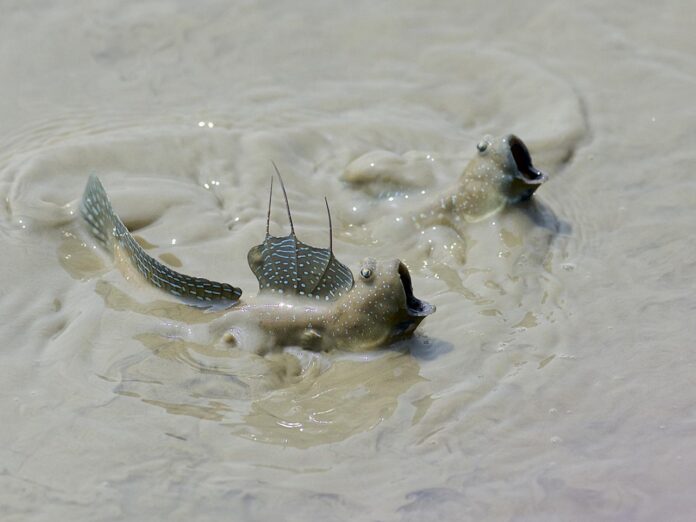The blinking behavior of the strange fish known as the mudskipper evolved to perform many of the same functions as our blinking.
A new study shows that blinking was among the qualities that evolved to allow tetrapods, the group of creatures that includes mammals, birds, reptiles, and amphibians, to move to live on land about 375 million years ago.
Stewart said, “Animals blink for many reasons. It helps us keep our eyes wet and clean, it helps us protect our eyes from injury, and we even use blinking for communication. Studying how this behavior first evolved has been challenging because the anatomical changes that allow blinking are mostly in soft tissues, which don’t preserve well in the fossil record. The mudskipper, which evolved its blinking behavior independently, allows us to test how and why blinking might have evolved in a living fish that regularly leaves the water to spend time on land.”
Researchers compared the anatomy of mudskippers to that of a closely related water-bound fish that does not blink to understand better how mudskippers gained the capacity to blink.
The eyes of the mudskipper bulge from the top of their heads like frog eyes, and to blink, the fish briefly pull their eyes back into their sockets, where they are protected by a flexible membrane known as a “dermal cup.” The duration of the mudskipper’s blink is comparable to that of a human blink.
The mudskipper, an uncommon blinking fish, spends much of the day out of the water, explaining how and why blinking might have originated during our ancestor‘s transition to life on land. According to new Penn State research, these amphibious fish have evolved a blinking behavior that fulfills many of the same functions as our blinking.
Blinking is something that humans and other tetrapods repeatedly do throughout the day, often without even realizing it, Blinking, although being a small motion, is rather intricate and fascinating, he added, because it is a single behavior that may fulfill numerous roles, all of which are vital to the health and safety of the vertebrate eye.
Aiello said, “Blinking in mudskippers appears to have evolved through a rearrangement of existing muscles that changed their line of action and also by the evolution of a novel tissue, the dermal cup. This is a very interesting result because it shows that a very rudimentary, or basic, system can be used to conduct a complex behavior. You don’t need to evolve a lot of new stuff to evolve this new behavior mudskipper just started using what they already had in a different way.”
The research team thought about the functions that blinking serves in humans and other tetrapods to understand why mudskippers blink on land. The scientists investigated whether mudskippers also blink to keep their eyes wet, as tears in humans are essential for maintaining healthy and oxygenated eye cells.
They found that mudskippers blink more frequently when faced with dry eyes, despite lacking tear glands and ducts.
He said, “What’s incredible is that they can use their blinks to wet the eyes, even though these fish haven’t evolved any tear glands or ducts. Whereas our tears are made by glands around our eyes and on our eyelids, mudskippers seem to be mixing mucus from the skin with water from their environment to produce a tear film.”
They also investigated if mudskippers’ blinking could be triggered to protect the eye from potential injury and whether blinking cleaned the fish’s eyes of dust or debris. As a result, blinking in mudskippers appears to fulfill three of the key tasks of blinking in humans and other tetrapods: protection, cleaning, and moisture maintenance.
The researcher said, “Our study, which considered the behavior and anatomy of a living fish that underwent a transition to life on land, similar to the earliest tetrapods, helps us to reimagine how and why these early tetrapods might have been blinking, Having the opportunity to study how and why this behavior first evolved provides an amazing opportunity to learn more about the way humans came to be as they are and gives us insight into changes associated with major transitions in the history of animals like inhabiting the land.”
A new study focused on the behavior and anatomy of a living fish that, like the earliest tetrapods, made the transition from aquatic to terrestrial existence.
Stewart said, “The transition to life on land required many anatomical changes, including changes for feeding, locomotion, and breathing air, Based on the fact that mudskipper blinking, which evolved completely independently from our fishy ancestors, serves many of the same functions as blinking in our lineage, we think that it was likely part of the suite of traits that evolved when tetrapods were adapting to life on land.”
The research was funded by the U.S. National Science Foundation, the Open Philosophy Project, the U.S. National Institutes of Health, the Biological Sciences Division of The University of Chicago, and the Brinson Foundation.
Journal Reference:
- Omar, A. K., Row, H., Mallory, et al. The mechanical theory of nonequilibrium coexistence and motility-induced phase separation. Proceedings of the National Academy of Sciences. DOI: 10.1073/pnas.2219900120
